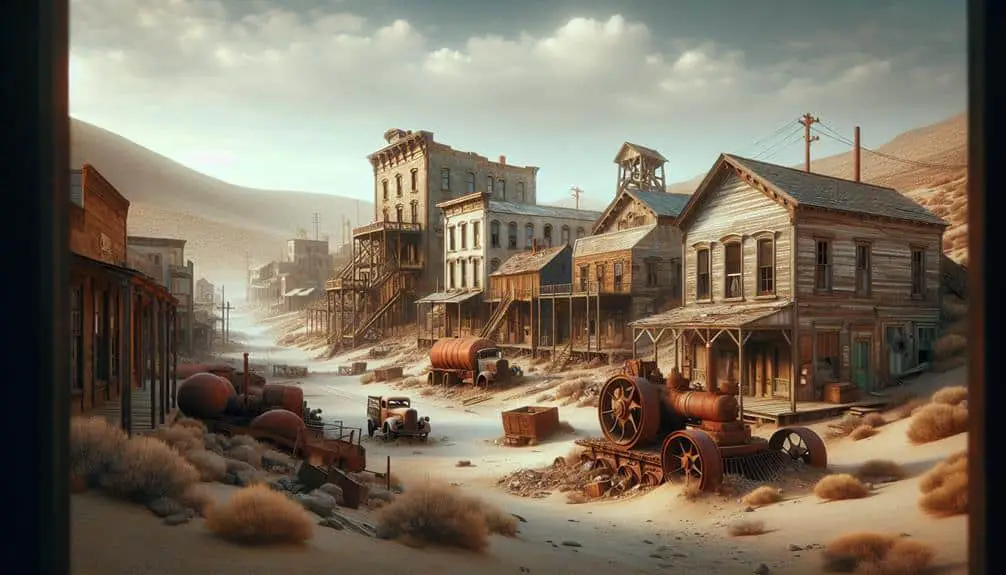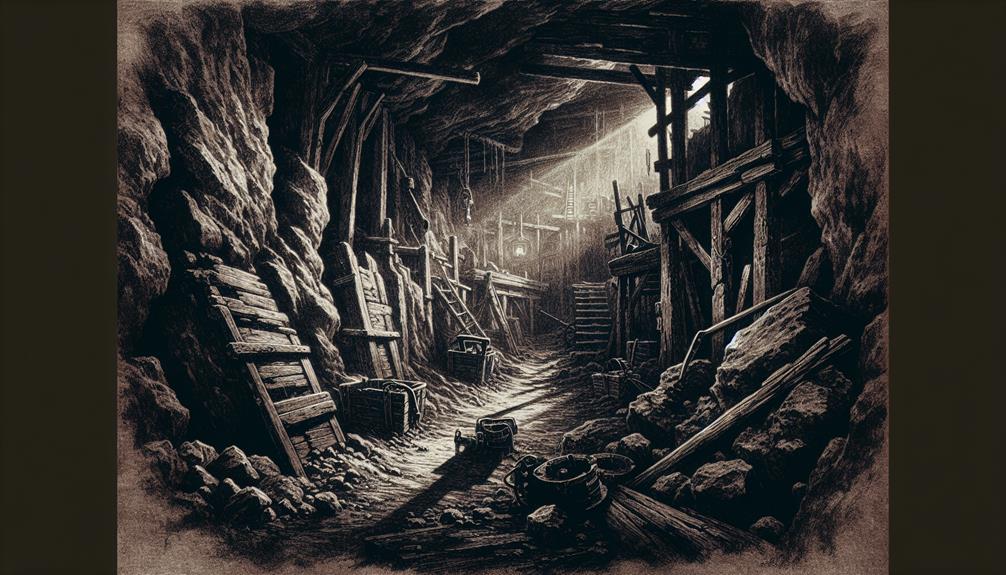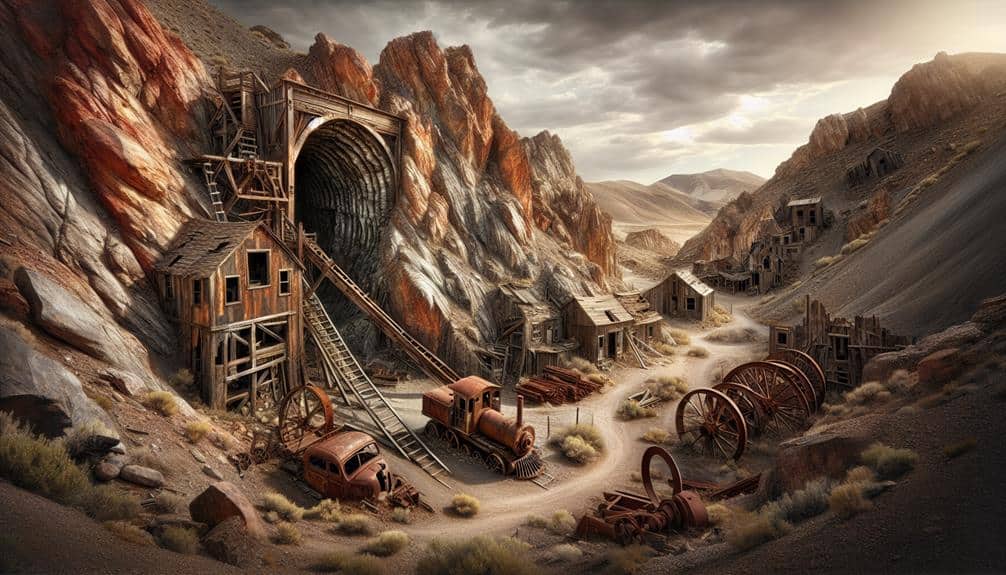Step into the rugged past of Nevada's mining towns where the echoes of fortune-seeking pioneers and booming silver mines reveal economic growth. The rise of towns like Virginia City and Tonopah symbolize the rich silver deposits driving a mining frenzy. The impact on the local economy diversifies economic activities and boosts urbanization. But challenges like fluctuating mineral prices and labor disputes shape the rise and fall of these communities. The architectural diversity, cultural artifacts, and preservation efforts showcase a rich cultural heritage awaiting exploration. Experience the legacy of Nevada's mining towns, where history breathes through the remnants of prosperity and perseverance.
Key Points
- Architectural diversity reflects past styles and ingenuity.
- Cultural artifacts offer insights into daily life.
- Community spirit lingers despite abandonment.
- Economic significance evident through industrial remnants.
- Historical resilience serves as a lesson in perseverance.
Booming Silver Mines in Nevada
During the late 19th century, Nevada's silver mines experienced a period of unprecedented growth and prosperity. The silver rush in Nevada during this time drew thousands of miners and fortune seekers to the region, leading to the rapid development of mining towns such as Virginia City and Tonopah. The discovery of rich silver deposits fueled a frenzy of mining activity, with miners using traditional methods such as pickaxes and shovels to extract the valuable ore from the earth.
As the demand for silver grew, so did the need for more efficient mining technology. Innovations such as the introduction of steam-powered stamp mills and the use of dynamite for blasting rock revolutionized the mining industry in Nevada. These advancements not only increased the speed and efficiency of extracting silver but also contributed to the overall economic growth of the region.
The combination of the silver rush and advancements in mining technology transformed Nevada into a hub of mining activity, shaping the state's history and laying the foundation for its future prosperity.
Impact of Mining on Local Economy
The mining industry in Nevada greatly affected the local economy, catalyzing a rapid transformation and diversification of economic activities in the region. Economic growth was fueled by the influx of capital investment and increased production levels, leading to a surge in prosperity for many communities. Job opportunities flourished as mining operations expanded, attracting workers from far and wide in search of employment in the burgeoning industry.
- Diversification of Economic Activities: Mining spurred the development of supporting industries such as transportation, lodging, and retail, creating a more robust local economy.
- Population Growth: The demand for labor in mines and related sectors drew people to Nevada, boosting population numbers and stimulating urbanization.
- Increased Infrastructure: Mining necessitated infrastructure improvements like roads, railways, and utilities, enhancing connectivity and accessibility in the region.
- Wealth Redistribution: The success of mining enterprises led to wealth accumulation among investors and workers, influencing spending patterns and investment opportunities.
- Technological Advancements: The quest for more efficient mining methods drove innovation and technological progress, impacting not just the industry but the broader economy as well.
Rise and Fall of Mining Communities
As mining communities flourished in Nevada due to the economic boom, their rise and eventual decline tell a compelling tale of cyclical prosperity and challenges. The initial rise of these towns was marked by a surge in population, construction of infrastructure, and economic growth driven by the mining industry. However, the boom period often led to rapid urbanization, strained resources, and environmental degradation.
Despite facing various hardships, such as fluctuating mineral prices and labor disputes, many mining communities showcased remarkable resilience. They fostered tight-knit social structures, established schools, churches, and other communal facilities, creating a sense of belonging among residents. This community resilience was evident in how residents supported each other during tough times, organized events, and maintained a collective identity.
Unfortunately, the decline of mining communities was often as swift as their rise. Factors like depleted resources, technological advancements, and changing economic landscapes contributed to their fall. As mines closed, populations dwindled, businesses shuttered, and once-thriving towns became ghostly remnants of their former selves. The rise and decline of these mining communities serve as a reminder of the ebb and flow of economic fortunes and the enduring spirit of community resilience.
Cultural Heritage of Abandoned Towns
Exploring the abandoned towns in Nevada unveils a diverse tapestry of cultural heritage intertwined with the echoes of bygone eras and the resilience of those who once called these places home. As you examine these ghostly remnants, you'll encounter architectural wonders that stand as proof of a bygone era. The cultural heritage of these abandoned towns speaks volumes about the lives led within their now empty streets. Here are some key aspects to ponder:
- Architectural Diversity: Each building tells a story of the past, reflecting the architectural styles of the time and the ingenuity of the residents who constructed them.
- Cultural Artifacts: Artifacts left behind offer insights into daily life, showcasing the customs and traditions of the people who once thrived in these towns.
- Community Spirit: Despite being abandoned, the sense of community lingers in the air, reminding visitors of the tight-knit bonds that once existed.
- Economic Significance: The economic activities that drove these towns can still be felt, with remnants of mines, mills, and other industrial structures dotting the landscape.
- Historical Resilience: The perseverance of these towns in the face of challenges serves as a lesson in resilience, inspiring reflection on the passage of time and the cyclical nature of history.
Preservation Efforts for Mining Relics
Amidst the rugged terrain of Nevada's mining towns, efforts to preserve the rich history encapsulated in the relics of past industry are gaining traction. Restoration projects aimed at conserving historical artifacts play an essential role in maintaining the integrity of these mining sites. These initiatives not only safeguard the tangible remains of Nevada's mining heritage but also offer a glimpse into the lives of the miners who once toiled in these now-abandoned towns.
Restoration projects focus on repairing and stabilizing structures such as old mine shafts, stamp mills, and miner's cabins. By maintaining these physical remnants, historians and archaeologists can piece together the story of Nevada's mining past. These efforts are critical in ensuring that future generations can appreciate the significance of these sites and the role they played in shaping the state's history.
Preservationists work tirelessly to prevent the decay and destruction of these relics, employing modern techniques to protect them from natural elements and human interference. Through these endeavors, the legacy of Nevada's mining towns continues to endure, allowing visitors to connect with the state's fascinating past.
Frequently Asked Questions
What Were the Living Conditions Like for Miners and Their Families in Nevada Mining Towns During the Peak of the Silver Mining Boom?
Living conditions in Nevada mining towns were harsh. Families faced cramped quarters, lack of sanitation, and limited access to basic necessities. Family dynamics were strained by long work hours and the constant threat of accidents.
How Did the Presence of Mining Towns in Nevada Impact the Local Indigenous Communities and Their Traditional Way of Life?
When mining towns spread across Nevada, they disrupted indigenous communities' traditional way of life. The influx of settlers altered cultural practices and strained relations with native peoples. This upheaval left a lasting impact on the region's diverse heritage.
Are There Any Famous Ghost Stories or Legends Associated With Specific Abandoned Mining Towns in Nevada?
In Nevada's deserted mining towns, chilling stories and otherworldly encounters are plentiful. Mythology tells of enigmatic occurrences, attracting tourists to investigate the spooky remains. Immerse yourself in the legends, and reveal the bone-chilling stories concealed within.
How Have Modern Technologies and Advancements in Mining Affected the Preservation Efforts for Historical Mining Relics in Nevada?
When it comes to the preservation challenges of historical mining relics in Nevada, modern mining technology has both aided and complicated conservation efforts. Balancing progress with historical significance is key in ensuring these relics endure for future generations.
What Role Did Women Play in the Nevada Mining Towns, Both in Terms of Labor and Social Influence?
In the rugged tapestry of Nevada mining towns, women's roles were like hidden gems, shaping both labor and social spheres. Their resilience and camaraderie wove a rich fabric that bound the community dynamics together.



